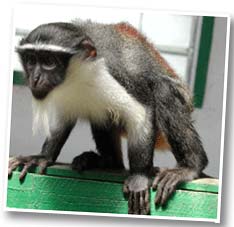

The
Research Project
The Study Area
Background Information
Tools Of The Trade
A Day In The Life Of . . .
Background Information
 The
Roloway guenon (scientific name: Ceropithecus Diana roloway) is a subspecies
of the Diana guenon (scientific name: Cercopithecus Diana). The local
Twi name for the Roloway monkey however is Boapea (pronounced boh-ah-pee-ah).
The
Roloway guenon (scientific name: Ceropithecus Diana roloway) is a subspecies
of the Diana guenon (scientific name: Cercopithecus Diana). The local
Twi name for the Roloway monkey however is Boapea (pronounced boh-ah-pee-ah).
Roloway monkeys are extremely endangered due to loss of habitat as they are found mostly in mature undisturbed forests. Sadly, they don’t appear to be very adaptable (easily adjust) to changes in their habitat making them particularly vulnerable to human activity.
There has only been one other known study on Roloway monkeys. For this reason alone, Lindsay’s study is important. Lindsay is attempting to determine the current distribution (where they are located) and their status (how many are there left). Additionally, she is looking for patterns in how the monkeys use their habitat. Knowing all of this will allow for the Ghanaian government to focus on preserving areas that are key for their survival. Lindsay will make recommendations and form a conservation action plan in her final project report.
Moreover, studying Roloway monkeys is important because scientists believe that the health of primate populations often an indicator of the health of the ecosystem in which they live.
So What Is Known?
Not much! Because Roloway monkeys have rarely been studied, not much is known about them. Though the Diana monkey, found in Cote d’Ivoire, has been studied extensively.
Historically, Diana monkeys were found in West Africa between Gambia and Ghana. Roloways are only found in Ghana and eastern Cote d’Ivoire however. As for primates the world over, their habitat areas are decreasing and populations are becoming increasingly isolated. What is known for certain is that their populations are also decreasing throughout the area where they are found.
Known Facts
Communication
Like all monkeys, Roloways communicate vocally. Their calls are used to alert the group to a predator or another monkey troop. It is a warning signal of danger. Males may also call to bring the troop back together if they have moved too far apart.
Roloways also communicate visually. They stare when they are
threatening another monkey or enemy. When they do this they also raise
their eyebrows which pushes their scalp backwards, showing off the bright
white fur on their brow line. Sometimes they also stare with their mouths
open but not showing their teeth. This is also a threatening stance. Other
times they also bob their heads while staring.